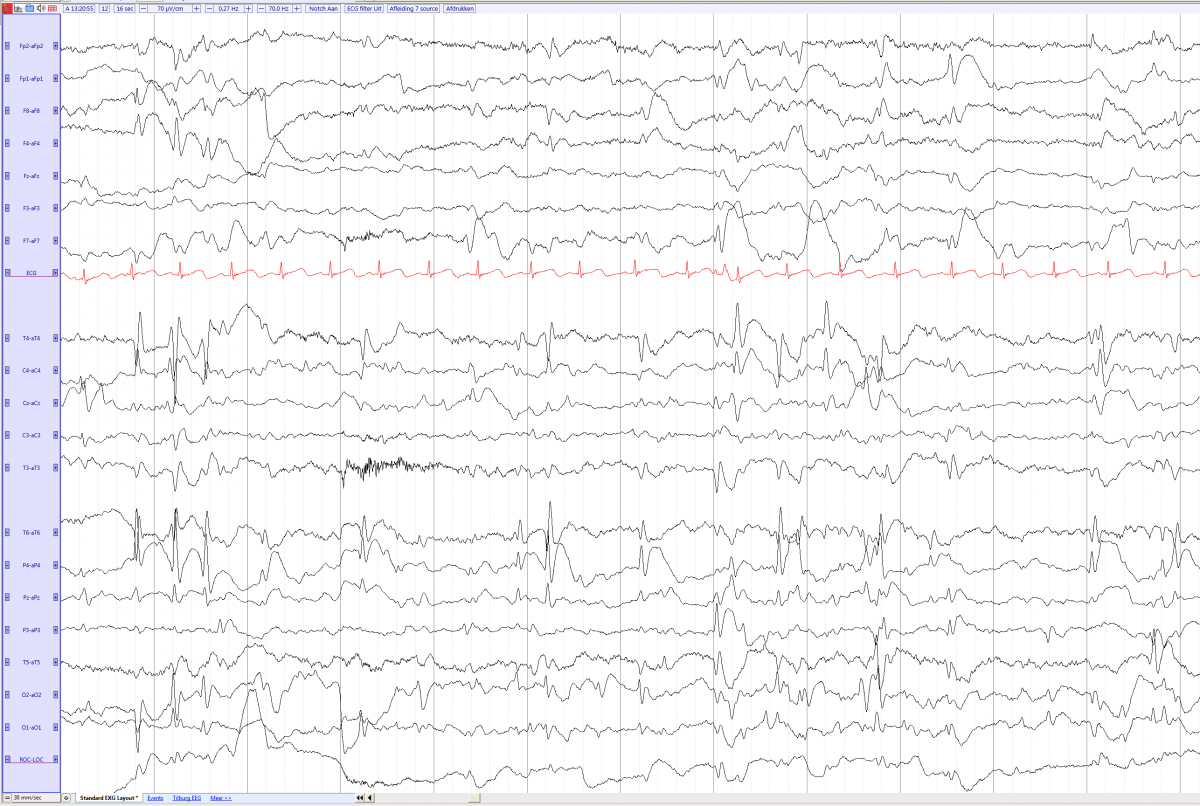Difference between revisions of "Lennox Gastaut Syndrome"
From EEGpedia
(Created page with "==Background== * Severe seizures in childhood * Presentation before eight years of age, most commonly between three and five years of age * Many cases evolve into Lennox Gasta...") |
|||
| (One intermediate revision by the same user not shown) | |||
| Line 18: | Line 18: | ||
==EEG== | ==EEG== | ||
| − | * Spike | + | * [[Spike slow wave complex]] superimposed on an abnormal, slow background. |
| − | * The [[Spike slow wave complex]] and [[Sharp wave slow wave complex]] are generalized at a frequency of 1.5 to 2.5 Hz (slow) | + | * The [[Spike slow wave complex]] and [[Sharp wave slow wave complex]] are generalized at a frequency of 1.5 to 2.5 Hz (slow), usually with the highest amplitude frontal. |
* Transient and shifting asymmetries are frequent | * Transient and shifting asymmetries are frequent | ||
* Non-REM sleep increases the discharges. In REM sleep the discharges decreases. | * Non-REM sleep increases the discharges. In REM sleep the discharges decreases. | ||
| Line 33: | Line 33: | ||
* Valproic acid, lamotrigine, topiramate, rufinamide, felbamate, and clobazam can be effective | * Valproic acid, lamotrigine, topiramate, rufinamide, felbamate, and clobazam can be effective | ||
* Carbamazepine can worsen the drop attacks | * Carbamazepine can worsen the drop attacks | ||
| + | |||
| + | |||
| + | ---- | ||
| + | |||
| + | '''''Lennox gastaut in a 3 years and 10 months old boy (source) with multiple spike and slow waves and a slow basic rhythm''''' | ||
| + | [[File:Lennox_gastaut_in_a_3_years_and_10_months_old_boy_(source)_EEGpedia.png|border|none|1200px|left]] | ||
| + | |||
| + | |||
| + | ---- | ||
Latest revision as of 15:16, 4 August 2017
Contents
Background
- Severe seizures in childhood
- Presentation before eight years of age, most commonly between three and five years of age
- Many cases evolve into Lennox Gastaut from other epilepsy syndromes, particularly West Syndrome (Infantile Spasm)
Clinics
- Mixture of seizure types
- Tonic
- Tonic-clonic
- Atonic (drop attacks)
- Myoclonic
- atypical absences
- Brief tonic seizures of seconds to 1 minute.
- The seizures can cause falls.
- Eyelid retraction, staring, mydriasis, and apnea are commonly associated
- The seizures are frequent
- Mental retardation before seizure onset in 20-60%
EEG
- Spike slow wave complex superimposed on an abnormal, slow background.
- The Spike slow wave complex and Sharp wave slow wave complex are generalized at a frequency of 1.5 to 2.5 Hz (slow), usually with the highest amplitude frontal.
- Transient and shifting asymmetries are frequent
- Non-REM sleep increases the discharges. In REM sleep the discharges decreases.
- Hyperventilation or photic stimulation does not trigger the discharges.
Ictal EEG
- Tonic seizure: typically fast rhythmic discarges of 10 – 20 Hz, increasing in amplitude.
- Myoclonic seizures: bursts of arrhythmic, multiple spike-wave or irregular spike-wave activity
- Atypical absence seizures: Slow (<2.5 Hz) and often asymmetric and irregular spike-and-wave activity
Treatment
- No drug is highly effective
- Valproic acid, lamotrigine, topiramate, rufinamide, felbamate, and clobazam can be effective
- Carbamazepine can worsen the drop attacks
Lennox gastaut in a 3 years and 10 months old boy (source) with multiple spike and slow waves and a slow basic rhythm
